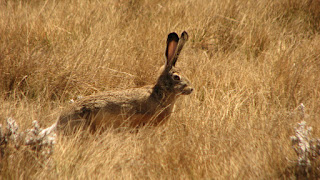Hello again, welcome back to animals under threat. Today,
we will be covering an animal that looks like a giant fox that lives in South
America and has the nickname “fox on stilts”. It is the only known species in
the genus Chrysocyon and belongs to the Canidae family. Please give a warm
welcome to the Maned Wolf (Chrysocyon brachyurus).
The Maned wolf is a largest canid that resides in Central
and Eastern South America. It is characterized by its red fur similar to the
red fox and stands on end giving the appearance of a mane. Black markings on
its long legs, muzzle and the tips of the mane. It also has a white bib
underneath its muzzle and on the tip of its tail (nationalzoo.si.edu, 2020). Its
preferred habitat are grasslands, swamps, scrub forest, woodlands with open
canopy and mixed forest. Maned wolfs can reach a height of 1m and can weigh
over 20-25kgs (wwf.panda.org, 2020).
Chrysocyon
brachyurus by Edu Fortes
The Maned wolf is an omnivore which means its diet is both
meat and vegetation material. It feeds on small mammals, birds and fish, but
majority of its diet is plant martial that includes sugar cane, tubers, and
fruit. The most common plant found in Maned wolf fecal matter is the
Solanum
lycocarpum or Wolf Apple (Aragona & Setz, 2001). A graph from the article
“feeding habits of the Maned wolf, Chrysocyon brachyurus (Carnivora: Canidae),
in southeast Brazil" shows that during the dry season, Maned wolves mostly
fed on small mammals and the wolf apple. During wet season, the diet changes to
fruits that are more plentiful during that season (de Arruda Bueno &
Motta-Junior, 2009).
Wolf
fruit By João Medeiros (above) and graph by de
Arruda Bueno, A. & Motta-Junior, J.C. 2009 (below)
Maned wolves are mostly solitary animals unlike most wolf
species and only get together when it is breeding season. They use urine to
mark their territory, hunting paths or where they buried prey. Mating season
for Maned wolves is between November to April and gestation can last up to 60
days. A female Maned wolf can have up to 2-6 pups in a litter and the pups have
dark black fur compared to their parents. After 3 weeks, the pups fur begins to
turn red and follow their mother while she forges for food. Both parents do
care for the pups, but the female does most of the work, up to one year where
they are fully matured and leave the parent territory to find their own (Mannise
et al, 2017).
(wolf
pup 1) by Michael stone (above) and (wolf
pup 2) by Trisha M Shears
The Maned wolf is classed by the IUCN red list as near threatened
as there are currently four major threats to this species. The first threat is
habitat loss/alteration for crops has affected the wolfs food supply as a
majority of the wolfs diet is vegetation. Human persecution is the second
threat as the Maned wolf is blamed for the attacks on livestock and are killed
in retaliation. The third threat is vehicular collision as increasing traffic
on highways has led increase in fatality in Maned wolfs crossing the roads. The
final threat is pathogens introduced by domestic animals. Pathogens such as
canine distemper virus and canine adenovirus can affect both pups and adults
leading to fatalities (Paula & DeMatteo, 2015).
Next time, we will be covering a species of bird from the
genus Cygnus that was at the brink of extinction but is making a comeback.
References
Aragona, M. & Setz, E.Z.F. 2001, "Diet of the
maned wolf, Chrysocyon brachyurus (Mammalia: Canidae), during wet and dry
seasons at Ibitipoca State Park, Brazil", Journal of Zoology, vol. 254,
no. 1, pp. 131-136
de Arruda Bueno, A. & Motta-Junior, J.C. 2009,
"Feeding habits of the maned wolf, Chrysocyon brachyurus (Carnivora:
Canidae), in southeast Brazil", Studies on Neotropical Fauna and
Environment, vol. 44, no. 2, pp. 67-75.
https://nationalzoo.si.edu/animals/maned-wolf
retrieved 25/03/2020
Mannise, N., Cosse, M., González, S., Emmons, L.H.,
Duarte, J.M.B., Beccaceci, M.D. & Maldonado, J.E. 2017, "Maned wolves
retain moderate levels of genetic diversity and gene flow despite drastic
habitat fragmentation", Endangered Species Research, vol. 34, pp. 449-462.
Paula, R.C. & DeMatteo, K. 2015. Chrysocyon
brachyurus (errata version published in 2016). The IUCN Red List of Threatened
Species 2015: e.T4819A88135664
https://wwf.panda.org/our_work/wildlife/profiles/mammals/wolf_maned/
retrieved 25/03/202
picture references
https://www.iucnredlist.org/species/4819/88135664
(maned wolf 1 Edu Fortes)
https://en.wikipedia.org/wiki/Maned_wolf
Wolf fruit By João Medeiros
de Arruda Bueno, A. & Motta-Junior, J.C. 2009,
"Feeding habits of the maned wolf, Chrysocyon brachyurus (Carnivora:
Canidae), in southeast Brazil", Studies on Neotropical Fauna and
Environment, vol. 44, no. 2, pp. 67-75. (graph)
https://en.wikipedia.org/wiki/Maned_wolf
(wolf pup 1) by Michael stone

































